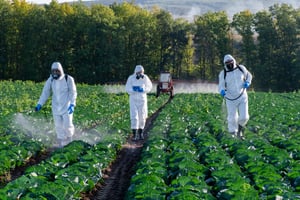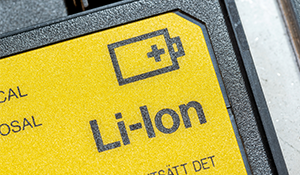Even though a pesticide has been in wide use, it may not be free of extremely negative downsides....
Monitoring Hydrocarbon Contamination
Petroleum hydrocarbon contamination in water and soil is increasingly common around the world. This type of contamination can be introduced to the environment by a known event, such as a spill, but hydrocarbons are also introduced continuously at low concentrations from sources like manufacturing, power generation and storm and wastewater. Once present in soil or water, hydrocarbons can spread through the environment, entering the food chain, contaminating drinking water and impacting the usability of land. The full scope of the effect hydrocarbon contamination can have on the environment is not fully known.
When petroleum-derived compounds are found in environmental samples, comprehensive information is required to develop and implement an effective remediation plan. As a result, an accurate system for screening is essential.

Analysis Best Practices
Petroleum hydrocarbon contaminants can include a range of compounds. To ensure accurate identification, contamination is often measured by carbon range instead of by a particular fuel or oil type. The US Environmental Protection Agency (EPA), American Society for Testing and Materials (ASTM), several US states as well as other international regulatory agencies have defined carbon ranges and published methodologies for their analysis. Some examples of standard methods and defined carbon ranges are highlighted in table 1 and in the bullets below:
- EPA method 8015/ SW-846 is a method for the analysis of diesel range organics (DRO), gasoline range organics (GRO) and kerosene in solid, water and wipe samples.
- ISO 16703 is applicable to the determination of hydrocarbons with a boiling range of 175 °C to 525 °C, n-alkanes from C10 to C40 in soil and sediment using GC with flame ionization detection (FID).
- Chinese HJ 1020-2019 method is applicable for the determination of petroleum hydrocarbons from C6 to C9 using a purge and trap (P&T) with a GC/FID.
- ASTM D7678 standard is suitable for the determination of TPH in water and wastewater using mid-IR laser spectroscopy.
Table 1: Examples of carbon ranges defined by EPA and U.S. States
|
Term |
Agency |
Range |
|
DRO (Diesel Range Organics) |
US EPA |
C10-C28 |
|
|
Alaska |
C10-C25 |
|
|
Wisconsin |
C10-C28 |
|
EPH (Extractable Petroleum Hydrocarbons) |
Massachusetts |
C9-C36 |
|
GRO (Gasoline Range Organics) |
US EPA |
C6-C10 |
|
|
Alaska |
C6-C10 |
|
|
Wisconsin |
C6-C10 |
|
PRO (Petroleum Range Organics) |
Florida |
C8-C40 |
|
PVOC (Petroleum Volatile Organics Compounds) |
Wisconsin |
GRO (excluding naphthalene) |
|
TPH (Total Petroleum Hydrocarbons) |
Texas |
C6-C35 |
|
|
Washington |
C7-C30 |
|
VPH (Volatile Petroleum Hydrocarbons) |
Massachusetts |
C5-C12 |
Gas chromatography (GC) is one of the most used analytical techniques for quantitative analysis of petroleum hydrocarbons in environmental samples such as water, soil, and sediment. In GC methods, quantification is achieved by comparison to reference standards. The accuracy of results is directly correlated to the quality of the standards used for instrument calibration.
Hydrocarbon analysis is performed by environmental testing labs, municipalities and throughout the petroleum supply chain at places like oil depots or refineries to ensure compliance with regulatory guidelines. Data is used for critical decision making and for comparison against remediation guidelines when applicable. There can be no doubt of the data accuracy in these critical applications.
The Analytichem Solution
Chem Service has been a trusted manufacturer of high-quality organic standards for GC calibration for decades. Our petroleum hydrocarbon reference material portfolio includes neat materials and pre-configured mixtures for specific methods or agency requirements. Whether you are running analysis per US state guidance, like Massachusetts or Wisconsin, or running standard methods defined by the EPA or other regulatory agencies, you can trust our standards in your lab.
Now part of the Analytichem Group, the Chem Service range of petroleum hydrocarbon reference materials is conveniently available alongside Conostan oil standards and SCP Science sample preparation equipment.
Contact us today to discuss how we can support your hydrocarbon analysis.
Resources
- Huan Gao, Manli Wu, Heng Liu, & Zeliang Liu. (2021, November 18). Effect of petroleum hydrocarbon pollution levels on the soil microecosystem and ecological function. Environmental Pollution. https://www.sciencedirect.com/science/article/abs/pii/S0269749121020935
- ISO 36637, https://www.iso.org/standard/39937.html
- EPA method 8015D, https://www.epa.gov/esam/epa-method-8015d-sw-846-nonhalogenated-organics-using-gcfid
- ASTM D7678, https://www.astm.org/d7678-17r22.html
- Sustainability 2022, 14, 16948. https://doi.org/10.3390/su142416948

.png?width=50&name=MicrosoftTeams-image%20(1).png)




